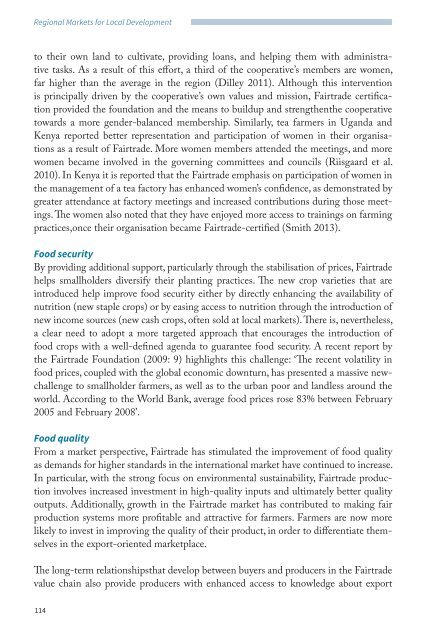Regional Markets
56ec00c44c641_local-markets-book_complete_LR
56ec00c44c641_local-markets-book_complete_LR
Create successful ePaper yourself
Turn your PDF publications into a flip-book with our unique Google optimized e-Paper software.
<strong>Regional</strong> <strong>Markets</strong> for Local Development<br />
to their own land to cultivate, providing loans, and helping them with administrative<br />
tasks. As a result of this effort, a third of the cooperative’s members are women,<br />
far higher than the average in the region (Dilley 2011). Although this intervention<br />
is principally driven by the cooperative’s own values and mission, Fairtrade certification<br />
provided the foundation and the means to buildup and strengthenthe cooperative<br />
towards a more gender-balanced membership. Similarly, tea farmers in Uganda and<br />
Kenya reported better representation and participation of women in their organisations<br />
as a result of Fairtrade. More women members attended the meetings, and more<br />
women became involved in the governing committees and councils (Riisgaard et al.<br />
2010). In Kenya it is reported that the Fairtrade emphasis on participation of women in<br />
the management of a tea factory has enhanced women’s confidence, as demonstrated by<br />
greater attendance at factory meetings and increased contributions during those meetings.<br />
The women also noted that they have enjoyed more access to trainings on farming<br />
practices,once their organisation became Fairtrade-certified (Smith 2013).<br />
Food security<br />
By providing additional support, particularly through the stabilisation of prices, Fairtrade<br />
helps smallholders diversify their planting practices. The new crop varieties that are<br />
introduced help improve food security either by directly enhancing the availability of<br />
nutrition (new staple crops) or by easing access to nutrition through the introduction of<br />
new income sources (new cash crops, often sold at local markets). There is, never theless,<br />
a clear need to adopt a more targeted approach that encourages the introduction of<br />
food crops with a well-defined agenda to guarantee food security. A recent report by<br />
the Fairtrade Foundation (2009: 9) highlights this challenge: ‘The recent volatility in<br />
food prices, coupled with the global economic downturn, has presented a massive newchallenge<br />
to smallholder farmers, as well as to the urban poor and landless around the<br />
world. According to the World Bank, average food prices rose 83% between February<br />
2005 and February 2008’.<br />
Food quality<br />
From a market perspective, Fairtrade has stimulated the improvement of food quality<br />
as demands for higher standards in the international market have continued to increase.<br />
In particular, with the strong focus on environmental sustainability, Fairtrade production<br />
involves increased investment in high-quality inputs and ultimately better quality<br />
outputs. Additionally, growth in the Fairtrade market has contributed to making fair<br />
production systems more profitable and attractive for farmers. Farmers are now more<br />
likely to invest in improving the quality of their product, in order to differentiate themselves<br />
in the export-oriented marketplace.<br />
The long-term relationshipsthat develop between buyers and producers in the Fairtrade<br />
value chain also provide producers with enhanced access to knowledge about export<br />
114


